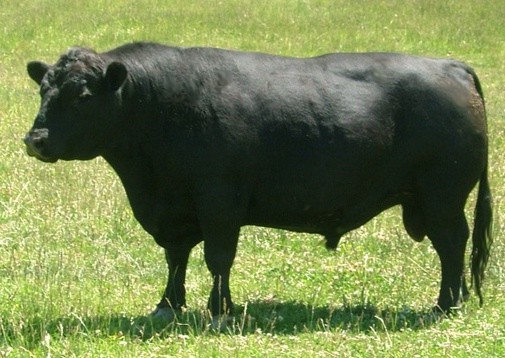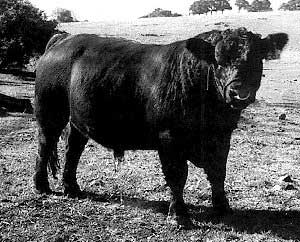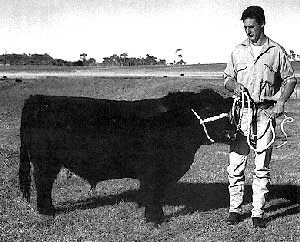Australian Lowline Cattle
 Lowline cattle were developed as a part of a major research project initiated at Trangie
Agricultural Research Centre in 1974 to investigate the implications of selection
for growth rate.
Lowline cattle were developed as a part of a major research project initiated at Trangie
Agricultural Research Centre in 1974 to investigate the implications of selection
for growth rate.
Initially, 85 low growth rate cows were selected from the Trangie Angusherd to establish the original "Lowline" herd. These cows were joined to yearling bulls also selected for low growth rate from birth to yearling age. At the same time a high growth rate line (Highline) and a randomly selected line (Controline) were established. This unique experimental method was chosen to generate a rapid divergence in growth rate, through conventional within herd selection, in the shortest possible time.
 Since 1974, the Lowline herd has remained completely closed, with all replacement
bulls and heifers selected from within the line on the basis of low growth rate performance.
As a consequence, Lowline animals are now smaller than the Control and Highline animals
at all stages, from birth to maturity.
Since 1974, the Lowline herd has remained completely closed, with all replacement
bulls and heifers selected from within the line on the basis of low growth rate performance.
As a consequence, Lowline animals are now smaller than the Control and Highline animals
at all stages, from birth to maturity.
In the early 1990's Lowline were released into industry by the Trangie Research Centre and, on Saturday 5 August 1992 at a meeting of 14 interested persons, the Australian Lowline Cattle Association (ALCA) was formed. The name LOWLINE was unanimously endorsed with Australian denoting the indigenous characteristic of these cattle.
Lowline cattle are very definitely a beef breed. They are always black, naturally polled and at all stages of their growth are 60% of the size of normal beef breeds. As they stand today, they are generally the smallest breed of beef cattle.
 At birth, calves average 20-24kg (45-53 lbs). Their growth rate is very rapid at first,
due to the fact that the dams make excellent mothers and provide ample milk, and most
double their birth weight during the first six weeks. Mature cows can carry a calf
at the teat up until the calf is about 8 months.
At birth, calves average 20-24kg (45-53 lbs). Their growth rate is very rapid at first,
due to the fact that the dams make excellent mothers and provide ample milk, and most
double their birth weight during the first six weeks. Mature cows can carry a calf
at the teat up until the calf is about 8 months.
At 8 months, the heifers average 110kg (240 lbs) and bulls 140kg (300 lbs). As yearlings, they have increased to about 190kg (420 lbs) for heifers and 230kg (510 lbs) for bulls. Cows at maturity, 3 years, weigh a consistent average of 320kg (710 lbs) in good condition and stand between 95 and 105cm at the shoulder. The equivalent aged bulls, well muscled, top out at over 400kg (880 lbs) and stand between 100 and 110cm at the hip.
The females of the Lowline herd have some unique qualities to their physiological makeup. Heifers will not cycle until they have achieved a weight of approx. 220kg, which will occur when they are between 14 to 18 months of age. This has a tremendous management advantage for the small acre farmer in that heifers may continue to run with their virile brothers after weaning, without risk of conceiving until they achieve the critical weight, which is totally out of kilter with their bovine cousins which can and do begin to cycle much earlier. Clearly, this factor ensures easier paddock management and peace of mind for farmer and stud master.
Cattle of the herd are naturally docile and very easily handled. Some breeders handle their calves in a sheep race until they are about 12 months old as the calves are normally too small for a conventional calf cradle until they are 4 to 5 months old.
The Lowline is the perfect breed for the small acre farmer who can run 10 of these cattle compared with say, 6 Hereford or other similar breed. They are perfect for the family sized freezer and are not difficult to dress and slaughter "at home", giving 55% of overall live weight for consumption. The flesh is tender and well marbled, vis a vis their ancestors, the Angus, favoured by the Japanese perfectionists.
At the moment there are but 251 females in the Australian Herd (excluding 1993 born calves). There are 58 registered purebred bulls thereby providing a broad gene pool for the future.
Unlike most other breeds, grading up to purebred status it not permitted by the Association. This will, in the long term, maintain the breed's exclusivity, facilitate easier management of the Herd Book and ensure a high and consistent standard without risk of throwback.
Lowline do not carry the Achondroplasia (Dwarfism) gene and therefore there is no risk of genetically generated deformity or abortion. Calving losses are extremely small and even heifers show ease of calving.
Lowline produce premium small and exclusive beef cuts which are marketed as "Lowline Boutique Beef".
References
Australian Lowline Cattle Association Inc., University of New England, Armidale, NSW 2351
Phone: (02) 6773-3296
